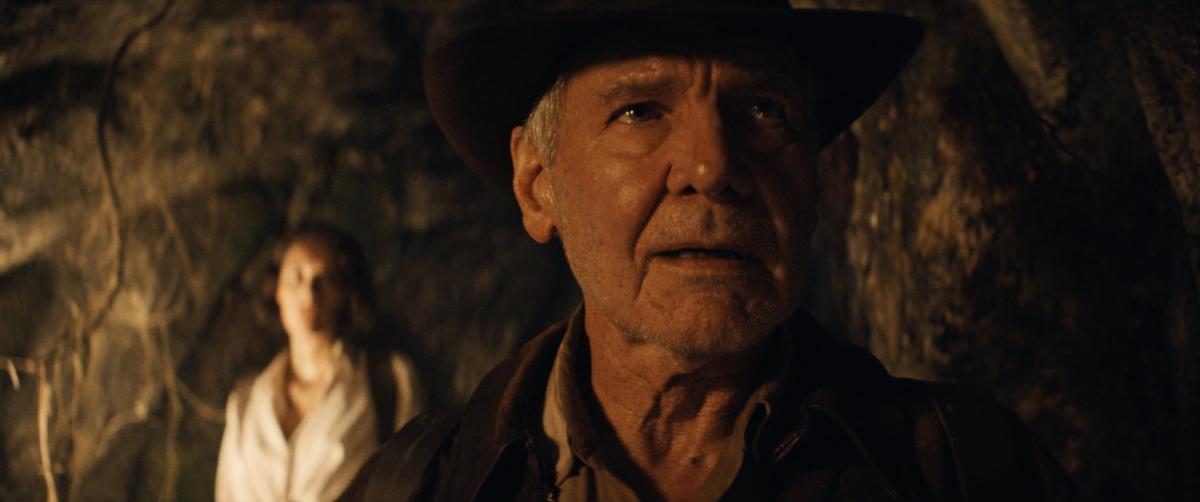
As the latest installment of the Indiana Jones saga begins, we’re back in WWII where we see a man with a burlap sack over his head who has been kidnapped by the Nazis. We know it’s Indy under that sack—who else? But how will the film handle it? The first Indiana Jones film, Raiders of the Lost Ark, set just before the war, was made in 1981 when star Harrison Ford was a robust 39 years old.
So who (or what) was going to be under that sack? A younger actor playing Indy? (Sacrilege!) Harrison Ford under pounds of prosthetics? Old footage unearthed from the original film? That de-aging software that Martin Scorsese used, with questionable results, in 2019’s The Irishman?
Well, they remove the bag and there’s . . .a fairly accurate approximation of what Harrison Ford looked like in 1981. They went with The Irishman option, although the “deep-fake” technology has improved in even these four short years. It really looks like Ford. I mean, knowing that some AI wizardry was involved, I clocked that his profile was a little wonky at times, that when he ran, his face got slightly blurry. But I can’t lie. If I hadn’t known it was deep fake, I’d have been none the wiser.
I have issues—moral, artistic, ethical—with this kind of technology (will they still be making Indiana Jones films long after Harrison Ford is dead?), but we can discuss those at a later date. The real question is: Does the world need any more Indiana Jones films?
I vividly remember seeing Raiders of the Lost Ark in the theater when I was a kid. It was one of the formative filmgoing experiences of my life. In my mind, its mixture of adventure, wit, and romance has yet to be surpassed. The two immediate sequels—Temple of Doom and The Last Crusade—were pretty good, too, albeit with diminishing returns. (There are some who think Temple of Doom is better than Raiders. To that I say, it takes all kinds.) Then, in 2008, they attempted to relaunch the franchise with Indiana Jones and the Kingdom of the Crystal Skull. I remember very little about that film except Shia LeBeouf played Indy and Marion’s son, there was a clever bit with a refrigerator, and Cate Blanchett had a funny haircut. The relaunch stalled.
And now here we are, back for another adventure. Is it another attempt at a relaunch? Another stab at bringing the world of Indy to Generation Z? Or is it more of a cash grab aimed at nostalgic Gen Xers like myself? I’m guessing the latter, considering that a 25 year old is not going to shell out their money to see a geriatric action star.
But I don’t think nostalgia alone is a good enough reason to relaunch a franchise—although I admit that when John Williams’ rousing Raiders theme song first played, it pinged a Pavlovian pleasure response in me.
To me, the only relevant questions are this: Is the film any good? And does it justify its own existence?
My answers: Meh. And not really.
That bit in the beginning establishes our villain: former Nazi and now contracted NASA scientist, Jürgen Voller (Mads Mikkelsen), who is obsessed with retrieving Archimedes’ “Dial of Destiny,” which purportedly allows people to time travel. It also establishes Indy’s friend and partner in crime, Basil Shaw (Toby Jones), a kind of fretful but loyal archeologist type whose hand shakes when he’s forced to fire a gun to save his pal. (He misses at first and clips Indy on the shoulder.)
There’s a set piece involving Nazis on a train (way worse than Snakes on a Plane, IMO) which, as action film rules dictate, ends up with Indy and Basil running for their lives on top of the train. They live and manage to snatch half of the Dial of Destiny.
Then we fast forward 25 years. It’s Indy’s last day teaching archeology at Hunter College. It also happens to be Moon Day. (There’s a parade in the street, along with a war protest, with lots of period fussiness by the costume department.) Unlike our first glimpse of the adventurer-professor in Raiders, the class is not enthralled. No girl is batting her eyelashes with the words “love you” painted on her lids. In fact, the kids seem bored. Only one student, a sharpie in velvet bell bottom pants and a vest, seems engaged. Later, we find out that she’s Helena Shaw (Phoebe Waller Bridge), Basil’s daughter and Indy’s goddaughter.
She’s come to hear more about the whereabouts of the second half of the Dial of Destiny, the pursuit of which drove her father insane. Indy tells her to leave it alone. As if.
But turns out Helena isn’t interested in the dial for its archeological value, as Indy is, nor for its promise of time travel, as Voller is. She’s a thief, and a good one, who sells her stolen goods on the Moroccan black market.
So she and Indy, sometimes in lockstep, sometimes at odds, will chase after the dial, while tailed by Voller and his henchmen (one of whom is impossibly, comically enormous). There’s also a young Moroccan boy named Teddy (Ethann Isidore) that Helena has befriended, an artful dodger type who pretends to be street smart and jaded but secretly yearns for Helena as a mother figure.
Helena is a nice foil to Indy—quick-witted and sly, a bit like Marion. (To be clear, nothing gross is happening here. Theirs is more of a complicated father-daughter relationship.)
I realize, as I describe this, that it all sounds kind of…good? The problem is, I’m describing the best parts. Dial of Destiny has the only the barest thread of a storyline on which to hang its many elaborate action scenes. One minute we’re on top of the aforementioned train, then we’re riding a horse through a subway (“subway’s faster,” Indy deadpans to a shocked woman when he jumps off the horse and escapes just as the doors slam shut), next we’re driving rickshaws through Tangier; we’re in a tomb, we’re in a parade, we’re underwater…. The action is ably choreographed by director James Mangold, but it gets increasingly ludicrous as the film goes on. At one point Teddy, who is about 14, suddenly has the ability to…fly a plane? And that’s not even the most absurd part of this particular sequence.
The film at least has the self respect to never have Indy utter the phrase, “I’m too old for this shit,” but it does seem a bit ambivalent about our hero’s advanced age. We see him struggling to climb a rock that Helena nimbly scales. We see him sacked out on the couch, only half-watching a black and white television set, in a bathrobe. And there is more than a hint of melancholy to this Indy. His son died in Vietnam (sorry, Shia), which caused a seemingly irreparable rift in his marriage to Marion (Karen Allen). But real emotions, real reflections on time and aging or a rapidly changing culture are merely glanced at.
Seeing Ford, still handsome, but craggy and gray-haired, slightly flabby with age, we’re supposed to reflect on our own mortality. But it’s up to us to feel (or not feel) a certain way. Nothing is made explicit. Instead, there’s some inevitable fan service with extended cameos by the original troupe of actors (and a welcome new player, Antonio Banderas, as a salty old sailor). A joke about snakes. (“Those eels look like snakes,” Helena says. “No they don’t,” Indy replies with a gulp.) And at least one more scene where Harrison Ford is made youthful by the magic of AI.
It all seems perfectly calibrated to suit the goals of the IP. I suspect we’ll be seeing Ford don the fedora and whip again soon—sometimes looking his actual age, sometimes looking younger—whether we like it or not.
